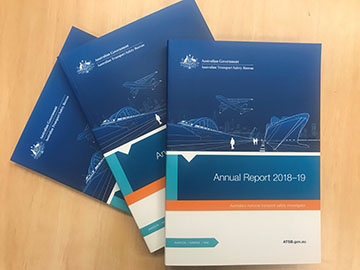The Australian Transport Safety Bureau (ATSB) has released its Annual Report, outlining its performance during 2018-19.

ATSB Chief Commissioner Greg Hood said the Bureau continued to make a significant contribution to transport safety in Australia, thanks to the release of several substantial and high-profile investigation reports, which contained valuable safety learnings for the aviation, rail and marine transport modes.
“There was much attention on the agency in September 2018 with the publication of the final report from our investigation into a King Air aircraft’s collision with a building in a retail precinct at Melbourne’s Essendon Airport in 2017,” Chief Commissioner Hood said.
“The investigation drew upon the ATSB’s world-leading human factors capabilities, which resulted in safety messaging around the use of checklists as an essential tool for overcoming limitations with pilot memory and ensuring action items are completed in sequence without omission. This messaging highlights the ATSB’s approach to safety investigation, which is to ensure that all relevant lessons can be learnt to help stop accidents in the future.”
The ATSB’s significant contribution to safety internationally during the year was highlighted by the release of the final report from the investigation into a serious incident involving an ATR 72 turboprop airliner, which experienced an inadvertent pitch disconnect following an in-flight upset.
“The investigation into this complex event identified a number of safety factors, including some in relation to the continuing airworthiness of the aircraft, and aircraft certification standards,” Chief Commissioner Hood said.
“As a consequence, the ATSB issued Safety Recommendations to the European Aviation Safety Agency to review the current design standards in consideration of the effect that dual pilot control inputs may have on the safe operation of an aircraft.”
Another key highlight outlined in the annual report is the ATSB’s entering into a strategic partnership with RMIT University, which is a central element of the ATSB’s vision to create a centre of excellence for accident investigation and transport safety in the Asia-Pacific region.
"If the public trusts that investigators, regulators and operators are identifying and managing safety risks, then they will have confidence in the safety of the transport system"
“If the public trusts that investigators, regulators and operators are identifying and managing safety risks, then they will have confidence in the safety of the transport system,” Chief Commissioner Hood said.
“A significant achievement to realising this objective is the partnership between the ATSB and RMIT University. The ATSB is focused on ensuring its own people have the highest investigative capabilities and in educating others to achieve the same.”
Also during the year the ATSB’s operational efficiency was audited by the Australian National Audit Office (ANAO), which found the Bureau has established key elements of an overall framework to promote efficient investigation processes.
“The ANAO found that our efficiency had been declining, but that we have been focussing our attention improving investigation timeframes and moving to benchmark our performance against transport investigation entities in other countries” Chief Commissioner Hood said.
“The ANAO acknowledged a number of actions had already been taken by the ATSB to make improvements, including formalising aspects of our program-managed approach to investigations.”
The ATSB was notified of 17,454 incident and accident notifications across the aviation, rail and marine transport modes in 2018-19, and completed 44 complex investigations during the period.
Chief Commissioner Hood said the ATSB is well-positioned to continue making its important contribution to improving transport safety.
“The ATSB has been through significant organisational change over the last few years, all directed towards enhancing our productivity and building on our shared vision of being a world-leading transport safety investigation agency,” Chief Commissioner Hood said.
“The ATSB’s staff are dedicated, hard-working experts in their field, and their contribution to safety is highly valued and internationally recognised. I intend to ensure they are empowered and enabled to continue to make this contribution well into the future.”


